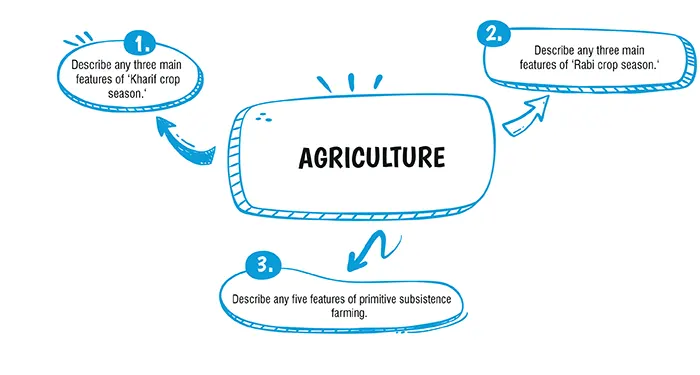Home / Boards / CBSE / Important Questions / Class 10 / Social Science / Agriculture
Table of Contents

Ans. (c)
Explanation:
This rearing of silkworms to produce silk is called sericulture.
Ans. (a)
Explanation:
India is the world's largest producer of milk, pulses and Jute. India ranks as the second-largest producer of rice, wheat, sugarcane, groundnut, vegetables, fruit and cotton.
Explanation:
Features of Kharif crop season :
(i) It begins with the onset of monsoon in May.
(ii) Crops are harvested in September – October.
(iii) Requires more rainfall between 100-110 cm.
(iv) It requires loamy or alluvial soil.
Explanation:
Features of Rabi crop season :
(i) It begins with the withdrawal of the monsoon in October. They are sown in winters from October to December.
(ii) At the time of ripening, it requires bright sunshine and is harvested in Summer from April to June.
(iii) Crops depend on sub-soil moisture.
(iv) Requires less rainfall between 50-75 cm. Availability of precipitation during winter months due to western temperate cyclones help in the success of these crops.
Explanation:
The features of primitive subsistence farming are given below :
(i) It is practised on small patches of land with the help of primitive tools like hoe, dao and digging sticks with the help of family members.
(ii) It depends upon monsoons, natural fertility of soil and environmental suitability.
(iii) It is also called ‘slash and burn’ agriculture.
(iv) Farmers clear a patch of land and produce crops for their sustenance.
(v) When the soil fertility decreases, farmers shift to new area, clear forest by burning and again sow crops.
| Chapter No. | Chapter Name |
|---|---|
| History | |
| Chapter 1 | The Rise of Nationalism in Europe |
| Chapter 2 | Nationalism in India |
| Chapter 3 | The Making of a Global World |
| Chapter 4 | The Age of Industrialization |
| Chapter 5 | Print Culture and the Modern World |
| Geography | |
| Chapter 6 | Resources and Development |
| Chapter 7 | Forest and Wildlife Resources |
| Chapter 8 | Water Resources |
| Chapter 9 | Agriculture |
| Chapter 10 | Minerals and Energy Resources |
| Chapter 11 | Manufacturing Industries |
| Political Science | |
| Chapter 12 | Power – sharing |
| Chapter 13 | Federalism |
| Chapter 14 | Gender, Religion and Caste |
| Chapter 15 | Political Parties |
| Chapter 16 | Outcomes of Democracy |
| Economics | |
| Chapter 17 | Development |
| Chapter 18 | Sectors of the Indian Economy |
| Chapter 19 | Money and Credit |
| Chapter 20 | Globalization and The Indian Economy |
| Chapter Wise Important Questions for CBSE Board Class 10 Geography |
|---|
| Resources and Development |
| Forest and Wildlife Resources |
| Water Resources |
| Agriculture |
| Minerals and Energy Resources |
| Manufacturing Industries |
CBSE Important Questions Class 10
ICSE Important Questions Class 10
CBSE Important Questions Class 10
ICSE Important Questions Class 10